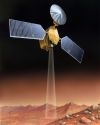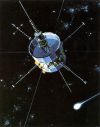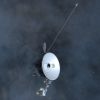Emily Lakdawalla • Jul 29, 2010
What's up in the solar system for August 2010
It seems it'll be a relatively routine month for our solar system explorers (if one can ever consider the exploration of an entire solar system by billion-dollar artificially intelligent robots "routine!"). Cassini will have a targeted encounter with Enceladus on August 13, but it's at an altitude of more than 2500 kilometers -- still close enough for some eye-popping photos, but less death-defying than the closest-ever encounter of 25 kilometers. And I think Mars Express is gearing up for another couple of weeks worth of Phobos encounters. It's nice, for once, to have quiet times on missions line up with vacation time on Earth. Take some time to go out and look at the show Venus is putting on in the night sky right now, and check out those Perseids on August 12!
...so, what ARE the "routine" planetary exploration activities of all of our robotic spacecraft?
In the inner solar system:
 NASA's MESSENGER spacecraft is cruising along, with only 231 days remaining until Mercury orbit insertion (which is planned for March 18, 2011). Check their gallery for their latest image releases, which seem to be coming out twice a month or so these days.
NASA's MESSENGER spacecraft is cruising along, with only 231 days remaining until Mercury orbit insertion (which is planned for March 18, 2011). Check their gallery for their latest image releases, which seem to be coming out twice a month or so these days.
 ESA's Venus Express is quietly orbiting our sister planet, under an extended mission proposed to last through 2012.
ESA's Venus Express is quietly orbiting our sister planet, under an extended mission proposed to last through 2012.
 JAXA's Akatsuki en route to join Venus Express at the second planet. Last month, it performed a trajectory correction maneuver using its ceramic thruster nozzle, a first, if I understand their press release correctly. It's scheduled to arrive at Venus in December.
JAXA's Akatsuki en route to join Venus Express at the second planet. Last month, it performed a trajectory correction maneuver using its ceramic thruster nozzle, a first, if I understand their press release correctly. It's scheduled to arrive at Venus in December.
 JAXA's IKAROS, too, is flying toward Venus, which is cool, but the real news is their achievement of full mission success last month. Again, congratulations to their team. There is now an English version of their press release describing attitude control using the LCD cells on their solar sail. Having achieved mission success, I'm not sure what their future plans for the spacecraft are. I assume there's more tests they can do to examine the performance of the vehicle and lay the groundwork for future missions, but I don't have any idea what those are.
JAXA's IKAROS, too, is flying toward Venus, which is cool, but the real news is their achievement of full mission success last month. Again, congratulations to their team. There is now an English version of their press release describing attitude control using the LCD cells on their solar sail. Having achieved mission success, I'm not sure what their future plans for the spacecraft are. I assume there's more tests they can do to examine the performance of the vehicle and lay the groundwork for future missions, but I don't have any idea what those are.
 NASA's Lunar Reconnaissance Orbiter is busily mapping the Moon from its science orbit. Lately, they have been posting their featured images with snippets from their wide-angle global mosaic for context, which is really helpful. The most recent pics, of the impact melts in Necho crater, are just lovely. Don't forget to check the LOLA image of the week site too.
NASA's Lunar Reconnaissance Orbiter is busily mapping the Moon from its science orbit. Lately, they have been posting their featured images with snippets from their wide-angle global mosaic for context, which is really helpful. The most recent pics, of the impact melts in Necho crater, are just lovely. Don't forget to check the LOLA image of the week site too.
On to Mars:
 Out at Mars, it's midwinter in the southern hemisphere, (it's currently Ls 125.3°), which means that the rovers' nights, though long, are getting shorter every sol. Today it is Mars Exploration Rover Spirit sol 2336 and Opportunity sol 2315. Spirit has still not been heard from since sol 2210 (March 22). The orbiters continue to listen for signals from Spirit during scheduled passes, and the Deep Space Network also listens every day. Opportunity is steadily driving eastward, eating up the kilometers separating her from the rim of Endeavour crater, and spotted her first dust devil last month. Here is Eduardo Tesheiner's latest route map and Google Earth kml file for Opportunity.
Out at Mars, it's midwinter in the southern hemisphere, (it's currently Ls 125.3°), which means that the rovers' nights, though long, are getting shorter every sol. Today it is Mars Exploration Rover Spirit sol 2336 and Opportunity sol 2315. Spirit has still not been heard from since sol 2210 (March 22). The orbiters continue to listen for signals from Spirit during scheduled passes, and the Deep Space Network also listens every day. Opportunity is steadily driving eastward, eating up the kilometers separating her from the rim of Endeavour crater, and spotted her first dust devil last month. Here is Eduardo Tesheiner's latest route map and Google Earth kml file for Opportunity.
 ESA's Mars Express mission has been quiet lately -- even the Mars Webcam didn't post any new pictures last month -- but I noted on my calendar that in August they will be doing another series of close encounters with Phobos, like the series of close encounters last March! I can't wait to see the newest pics...
ESA's Mars Express mission has been quiet lately -- even the Mars Webcam didn't post any new pictures last month -- but I noted on my calendar that in August they will be doing another series of close encounters with Phobos, like the series of close encounters last March! I can't wait to see the newest pics...
 Mars Reconnaissance Orbiter is humming along in normal science operations. The latest MARCI weather report describes the recent weather there as "uneventful." As always, check in on the latest captioned image releases from HiRISE for your dose of spectacular photos from Mars. I browsed the most recent ones and my favorite is the cute little impact feature visible in this image (note that the impact feature is not visible in the browse thumbnail -- you have to explore one of the full versions of the image, like this one, to locate it).
Mars Reconnaissance Orbiter is humming along in normal science operations. The latest MARCI weather report describes the recent weather there as "uneventful." As always, check in on the latest captioned image releases from HiRISE for your dose of spectacular photos from Mars. I browsed the most recent ones and my favorite is the cute little impact feature visible in this image (note that the impact feature is not visible in the browse thumbnail -- you have to explore one of the full versions of the image, like this one, to locate it).
 NASA's Mars Odyssey remains the longest-lived spacecraft in orbit at Mars. You can see the latest from its THEMIS instrument here. I like this one of a small side channel draining into the Nili Fossae region.
NASA's Mars Odyssey remains the longest-lived spacecraft in orbit at Mars. You can see the latest from its THEMIS instrument here. I like this one of a small side channel draining into the Nili Fossae region.
Exploring Saturn:
 The NASA-ESA-ASI Cassini mission is on the outbound leg of Rev 135, a low-inclination orbit with about a 20-day period; rev 136 starts on August 4. Thus there isn't a Looking Ahead article to tell us much about what's going to happen in August yet. There will be no close encounters with Titan, but there will be a targeted encounter of Enceladus on Friday, August 13. Although targeted, at an altitude of 2651 kilometers (or 5 Enceladus diameters) it's a bit more distant than past close flybys, which actually means it may be better for imaging -- at least for regional mapping at very good resolution. There are also Voyager-class flybys of Dione (about 110,000 kilometers, on August 13) and Tethys (37,000 kilometers, on August 14) but I don't know yet if imaging is planned. Watch the Looking Ahead page next week for more detailed information about upcoming plans.
The NASA-ESA-ASI Cassini mission is on the outbound leg of Rev 135, a low-inclination orbit with about a 20-day period; rev 136 starts on August 4. Thus there isn't a Looking Ahead article to tell us much about what's going to happen in August yet. There will be no close encounters with Titan, but there will be a targeted encounter of Enceladus on Friday, August 13. Although targeted, at an altitude of 2651 kilometers (or 5 Enceladus diameters) it's a bit more distant than past close flybys, which actually means it may be better for imaging -- at least for regional mapping at very good resolution. There are also Voyager-class flybys of Dione (about 110,000 kilometers, on August 13) and Tethys (37,000 kilometers, on August 14) but I don't know yet if imaging is planned. Watch the Looking Ahead page next week for more detailed information about upcoming plans.
Cruising from here to there:
 NASA's Deep Impact is now cruising toward a 700-kilometer flyby of comet 103P/Hartley 2, with closest approach planned for a few minutes before 14:00 UTC on November 4. Observations will begin on September 5 and continue through November 25, which will mark the end of scientific observations for the Deep Impact extended mission.
NASA's Deep Impact is now cruising toward a 700-kilometer flyby of comet 103P/Hartley 2, with closest approach planned for a few minutes before 14:00 UTC on November 4. Observations will begin on September 5 and continue through November 25, which will mark the end of scientific observations for the Deep Impact extended mission.
 Having completed the flyby of 21 Lutetia last month, ESA's Rosetta mission is hunkering down for a long, long, long cruise, much of which will be performed while it's in a state of hibernation, from July 2011 to January 2014. The next object it'll encounter will be its goal, comet 67/P Churyumov-Gerasimenko; rendezvous is set for May 2014.
Having completed the flyby of 21 Lutetia last month, ESA's Rosetta mission is hunkering down for a long, long, long cruise, much of which will be performed while it's in a state of hibernation, from July 2011 to January 2014. The next object it'll encounter will be its goal, comet 67/P Churyumov-Gerasimenko; rendezvous is set for May 2014.
 The International Cometary Explorer remains on course for a return visit to Earth in 2014. When it does, ICE can be returned to a Sun-Earth L1 halo orbit, or can use multiple Earth swingbys to encounter Comet Wirtanen during its near-Earth apparition in December 2018.
The International Cometary Explorer remains on course for a return visit to Earth in 2014. When it does, ICE can be returned to a Sun-Earth L1 halo orbit, or can use multiple Earth swingbys to encounter Comet Wirtanen during its near-Earth apparition in December 2018.
![]() NASA's Dawn is now in the asteroid belt for good, and is steadily thrusting with its ion engines, patiently propelling itself toward a rendezvous with Vesta in July 2011. I just posted Marc Rayman's latest Dawn Journal.
NASA's Dawn is now in the asteroid belt for good, and is steadily thrusting with its ion engines, patiently propelling itself toward a rendezvous with Vesta in July 2011. I just posted Marc Rayman's latest Dawn Journal.
 All systems on NASA's Stardust are "nominal" as less than a year remains until its flyby of comet Tempel 1. Closest approach will happen at 8:42 p.m. PST on February 14, 2011, or 04:42 February 15 UTC.
All systems on NASA's Stardust are "nominal" as less than a year remains until its flyby of comet Tempel 1. Closest approach will happen at 8:42 p.m. PST on February 14, 2011, or 04:42 February 15 UTC.
 NASA's New Horizons has 14.61 AU to go to reach Pluto. It's still on course for a January to July 2015 encounter with the Pluto and Charon system. If you visit their tracking page you can see how Jupiter was pretty close to the Sun in New Horizons' sky when it took that Jupiter system portrait last month.
NASA's New Horizons has 14.61 AU to go to reach Pluto. It's still on course for a January to July 2015 encounter with the Pluto and Charon system. If you visit their tracking page you can see how Jupiter was pretty close to the Sun in New Horizons' sky when it took that Jupiter system portrait last month.
And beyond:
 Finally, NASA's Voyager 1 and 2 spacecraft are still going strong. I'm enjoying following the relatively active Twitter feed of Voyager 2, which also mentions the position of Voyager 1 once a day.
Finally, NASA's Voyager 1 and 2 spacecraft are still going strong. I'm enjoying following the relatively active Twitter feed of Voyager 2, which also mentions the position of Voyager 1 once a day.
Some other milestones to take note of this month, taken from JPL's Space Calendar:
- There is a Small Bodies Assessment Group (SBAG) meeting next week in Pasadena, August 3 and 4.
- August 5: Happy 80th birthday to Neil Armstrong!
- August 6: Asteroid Itokawa will be at its closest approach to Earth. It's no coincidence that this happened shortly after Hayabusa's return -- Hayabusa started out, after all, from Itokawa's orbit.
- August 7: Mercury will be at its greatest eastern elongation
- August 10: It'll be 20 years since Magellan arrived at Venus.
- August 12: Perseids meteor shower peak
- August 20: Venus at its greatest eastern elongation; Neptune will be at opposition
- August 30-September 2: Venus Exploration Analysis Group (VEXAG) meeting, in Madison, Wisconsin
Oh, and, last but hardly least, happy 4th birthday to Anahita Lakdawalla!
Support our core enterprises
Your support powers our mission to explore worlds, find life, and defend Earth. You make all the difference when you make a gift. Give today!
Donate

 Explore Worlds
Explore Worlds Find Life
Find Life Defend Earth
Defend Earth

